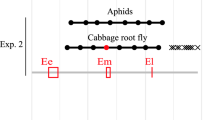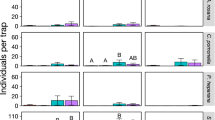Abstract
In agroecosystems, the efficiency of biocontrol agents could be improved through the artificial selection of specific traits that would enhance their zoophagy level. The aim of this study was to evaluate the impact of artificially selected populations of the omnivorous predatory bug, Nabis americoferus, on the tarnished plant bug, Lygus lineolaris, in organic strawberry crops. Six populations of N. americoferus were selected according to their aggressiveness, three were composed of highly aggressive individuals, whereas the other lines contained docile individuals. The first hypothesis was that, since aggressive predators display a higher attack rate, aggressive lines would exhibit a higher pest control and a better crop protection than docile lines. The second hypothesis was that, when two biocontrol agents species are used conjointly, the presence of at least one docile population would generate a higher synergy between both species. N. americoferus populations were released in an experimental strawberry field, with or without a second intraguild predator, the Anthocorid, Orius insidiosus. Results support the first hypothesis that the aggressive lines generate a better pest control and a better strawberries crop protection than docile lines but only at low pest density. The second hypothesis is neither supported nor rejected since the combination of docile lines and O. insidiosus led to a better pest control at high pest density, but led to a reduced crop protection at low pest density. Our study shows that the artificial selection of aggressiveness has the potential to improve the effectiveness of biocontrol programs.




Similar content being viewed by others
Data availability
Data are available on demand to the corresponding author.
References
Abrams PA, Schmitz OJ (1999) The effect of risk of mortality on the foraging behaviour of animals faced with time and digestive capacity constraints. Evol Ecol Res 1(3):285–301
Arnoldi D, Stewart RK, Boivin G (1991) Field survey and laboratory evaluation of the predator complex of Lygus lineolaris and Lygocoris communis (Hemiptera: Miridae) in apple orchards. J Econ Entomol 84(3):830–836. https://doi.org/10.1093/jee/84.3.830
Bernays EA (1997) Feeding by lepidopteran larvae is dangerous. Ecol Entomol 22(1):121–123. https://doi.org/10.1046/j.1365-2311.1997.00042.x
Bielza P, Balanza V, Cifuentes D, Mendoza JE (2020) Challenges facing arthropod biological control: identifying traits for genetic improvement of predators in protected crops. Pest Manag Sci 76(11):3517–3526. https://doi.org/10.1002/ps.5857
Bleicher SS (2017) The landscape of fear conceptual framework: definition and review of current applications and misuses. PeerJ 5:e3772. https://doi.org/10.7717/peerj.3772
Bolnick DI, Svanbäck R, Fordyce JA, Yang LH, Davis JM, Hulsey CD, Forister ML (2003) The ecology of individuals: incidence and implications of individual specialization. Am Nat 161:1–28. https://doi.org/10.1086/343878
Bolnick DI, Amarasekare P, Araújo MS, Bürger R, Levine JM, Novak M, Rudolf VHW, Schreiber SJ, Urban MC, Vasseur DA (2011) Why intraspecific trait variation matters in community ecology. Trends Ecol Evol 26:183–192. https://doi.org/10.1016/j.tree.2011.01.009
Braman SK, Sloderbeck PE, Yeargan KV (1984) Effects of temperature on the development and survival of Nabis americoferus and N. roseipennis (Hemiptera: Nabidae). Ann Entomol Soc Am 77(5):592–596. https://doi.org/10.1093/aesa/77.5.592
Cabello T, Gallego Granados JR, Fernandez-Maldonados FJ, Vila E (2009) The damsel bug Nabis pseudoferus (Hem.: Nabidae) as a new biological control agent of the South American Tomato Pinworm, Tuta absoluta (Lep.: Gelechiidae), in tomato crops of Spain. Integrated control in protected crops. Mediterr Clim IOBC/wprs 49:219–223
Carroll J, Pritts MP, Heidenreich C (eds) (2016) Production guide for organic strawberries. New York State Integrated Pest Management Program. Ithaca, New York
Danner BJ, Joern A (2003) Resource-mediated impact of spider predation risk on performance in the grasshopper Ageneotettix deorum (Orthoptera: Acrididae). Oecologia 137(3):352–359. https://doi.org/10.1007/s00442-003-1362-9
Dumont F, Provost C (2022) Using autumnal trap crops to manage tarnished plant bugs (Lygus lineolaris). InSects 13(5):441. https://doi.org/10.3390/insects13050441
Dumont F, Réale D, Lucas E (2017) Isogroup selection to optimize biocontrol increases cannibalism in omnivorous (Zoophytophagous) bugs. InSects 8(3):74. https://doi.org/10.3390/insects8030074
Dumont F, Aubry O, Lucas E (2018a) From evolutionary aspects of zoophytophagy to biological control. Front Ecol Evol 6:221. https://doi.org/10.3389/fevo.2018.00221
Dumont F, Provost C, Lucas E (2018b) Potential of the predatory bug Nabis americoferus and Orius insidiosus as biological control agent of Lygus lineolaris in organic strawberry field. CRAM.
Dumont F, Solà M, Provost C, Lucas E (2023) The Potential of Nabis americoferus and Orius insidiosus as biological control agents of lygus lineolaris in strawberry fields. InSects 14:385. https://doi.org/10.3390/insects14040385
Foster WA, Treherne JE (1981) Evidence for the dilution effect in the selfish herd from fish predation on a marine insect. Nature 293:466–467. https://doi.org/10.1038/293466a0
Hedrick AV, Riechert SE (1989) Genetically-based variation between two spider populations in foraging behavior. Oecologia 80(4):533–539. https://doi.org/10.1007/BF00380078
Hermann SL, Thaler JS (2014) Prey perception of predation risk: volatile chemical cues mediate non-consumptive effects of a predator on a herbivorous insect. Oecologia 176(3):669–676. https://doi.org/10.1007/s00442-014-3069-5
Kaplan I, McArt SH, Thaler JS (2014) Plant defenses and predation risk differentially shape patterns of consumption, growth, and digestive efficiency in a guild of leaf-chewing insects. PLoS ONE 9(4):e93714. https://doi.org/10.1371/journal.pone.0093714
Kortet R, Vainikka A, Janhunen M, Piironen J, Hyvärinen P (2014) Behavioral variation shows heritability in juvenile brown trout Salmo trutta. Behav Ecol Sociobiol 68(6):927–934. https://doi.org/10.1007/s00265-014-1705-z
LaFlair A (2022) Survey of Native Predatory Hemipterans and Assessment of Nabis americoferus Carayon (Hemiptera: Nabidae) as a Biological Control Agent of Lepidopteran Tomato Pests. University of Windsor (Canada). ProQuest Dissertations Publishing. Degree Year2022. https://scholar.uwindsor.ca/etd/8787
Leung K, Ras E, Ferguson KB, Ariëns S, Babendreier D, Bijma P et al (2020) Next-generation biological control: the need for integrating genetics and genomics. Biol Rev 95(6):1838–1854. https://doi.org/10.1111/brv.12641
Lirakis M, Magalhães S (2019) Does experimental evolution produce better biological control agents? A critical review of the evidence. Entomol Exp Appl 167(7):584–597. https://doi.org/10.1111/eea.12815
Lommen STE, de Jong PW, Pannebakker BA (2017) It is time to bridge the gap between exploring and exploiting: prospects for utilizing intraspecific genetic variation to optimize arthropods for augmentative pest control - a review. Entomol Exp Appl 162(2):108–123. https://doi.org/10.1111/eea.12510
Lucas E, Alomar O (2002) Impact of macrolophus caliginosus presence on damage production by Dicyphus tamaninii (Heteroptera: Miridae) on tomato fruits. J Econ Entomol 95(6):1123–1129. https://doi.org/10.1603/0022-0493-95.6.1123
Lucas E, Brodeur JA (2001) Fox in sheep’s clothing: furtive predators benefit from the communal defense of their prey. Ecology 82:3246–3250. https://doi.org/10.1890/0012-9658(2001)082[3246:AFISSC]2.0.CO;2
Lucas E, Labrecque C, Coderre D (2004) Delphastus catalinae (Horn) and coleomegilla maculata lengi timb. (Coleoptera: Coccinellidae) as biological control agents of the greenhouse whitefly, Trialeurodes vaporariorum (Homoptera: Aleyrodidae). Pest Manag Sci 60(11):1073–1078. https://doi.org/10.1002/ps.916
Lucas E, Fréchette B, Alomar O (2009) Resource quality, resource availability, and intraguild predation among omnivorous mirids. Biocontrol Sci Technol 19(6):555–572. https://doi.org/10.1080/09583150902883460
Maupin JL, Riechert SE (2000) Superfluous killing in spiders: a consequence of adaptation to food-limited environments? Behav Ecol 12(5):569–576. https://doi.org/10.1093/beheco/12.5.569
Michalko R, Řežucha R (2018) Top predator’s aggressiveness and mesopredator’s risk-aversion additively determines probability of predation. Behav Ecol Sociobiol 72:105. https://doi.org/10.1007/s00265-018-2520-8
Michalko R, Gibbons ALT, Goodacre SL, Pekár S (2021) Foraging aggressiveness determines trophic niche in a generalist biological control species. Behav Ecol 32(2):257–264. https://doi.org/10.1093/beheco/araa123
Peacor SD, Werner EE (2001) The contribution of trait-mediated indirect effects to the net effects of a predator. PNAS 98(7):3904–3908. https://doi.org/10.1073/pnas.07106199
Perkins PV, Watson TF (1972) Nabis alternatus as a Predator of Lygus Hesperus. Ann Entomol Soc Am 65(3):625–629. https://doi.org/10.1093/aesa/65.3.625
Pickett CH, Nieto DJ, Bryer JA, Swezey SL, Stadtherr M (2017) Long term post-release impacts of the introduced parasitoid Peristenus relictus (Hymenoptera: Braconidae) on Lygus spp. (Hemiptera: Miridae) populations in California. Biol Control 144:30–38. https://doi.org/10.1016/j.biocontrol.2017.07.002
Pintor LM, Sih A, Kerby JL (2009) Behavioral correlations provide a mechanism for explaining high invader densities and increased impacts on native prey. Ecology 90(3):581–587. https://doi.org/10.1890/08-0552.1
Réale D, Reader SM, Sol D, McDougall PT, Dingemanse NJ (2007) Integrating animal temperament within ecology and evolution. Biol Rev 82(2):291–318. https://doi.org/10.1111/j.1469-185X.2007.00010.x
Riechert SE, Hedrick AV (1993) A test for correlations among fitness linked behavioural traits in the spider Agelenopsis aperta (Araneae, Agelenidae). Anim Behav 46:669–675. https://doi.org/10.1006/anbe.1993.1243
Rothley KD, Schmitz OJ, Cohon JL (1997) Foraging to balance conflicting demands: novel insights from grasshoppers under predation risk. Behav Ecol 8(5):551–559. https://doi.org/10.1093/beheco/8.5.551
R Core Team (2020) R: A language and environment for statistical computing. R Foundation for Statistical Computing, Vienna, Austria. https://www.R-project.org/
Royer P, Dumont F, Provost C, Lucas E (2022) Selecting aggressiveness to improve biological control agents efficiency. J Pest Sci 95:1589–1596. https://doi.org/10.1007/s10340-022-01552-x
Royer P, Dumont F, Provost C, Martial Catubis K, Lucas E (2023) When the aggressiveness level modifies the intraguild predation magnitude. Biol Control 188:105385. https://doi.org/10.1016/j.biocontrol.2023.105385
Schmitz OJ (1998) Direct and indirect effects of predation and predation risk in old-field interaction webs. Am Nat 151(4):327–342. https://doi.org/10.1086/286122
Schmitz OJ, Beckerman AP, O’Brien KM (1997) Behaviorally mediated trophic cascades: effects of predation risk on food web interactions. Ecology 78(5):1388–1399. https://doi.org/10.1890/0012-9658(1997)078[1388:BMTCEO]2.0.CO;2
Scott WP, Snodgrass GL (2000) A review of chemical control of the tarnished plant bug in cotton. Southwestern Entomol (Suppl. 23):67–81. ISSN 0147–1724
Sih A, Cote J, Evans M, Fogarty S, Pruitt J (2012) Ecological implications of behavioural syndromes. Ecol 15:278–289. https://doi.org/10.1111/j.1461-0248.2011.01731.x
Tauber CA, Tauber MJ (1981) Insect seasonal cycles: genetics and evolution. Ann Rev Ecol Syst 12:281–308. https://www.jstor.org/stable/2097113
Turner GF, Pitcher TJ (1986) Attack abatement: a model for group protection by combined avoidance and dilution. Am Nat 128:228–240. https://doi.org/10.1086/284556
Turnock WJ, Fields PG (2005) Winter climates and coldhardiness in terrestrial insects. Eur J Entomol 102(4):561. https://doi.org/10.14411/eje.2005.081
Verbeek ME, Boon A, Drent PJ (1996) Exploration, aggressive behaviour and dominance in pair-wise confrontations of juvenile male great tits. Behaviour 133(11–12):945–963. https://doi.org/10.1163/156853996X00314
Villavaso EJ, Snodgrass GL (2004) Diapause in tarnished plant bug (Heteroptera: Miridae) reared in dynamic photoperiod environmental cabinets. J Agric Urban Entomol 21(2):87–97
Yasuda H, Kikuchi T, Kindlmann P, Sato S (2001) Relationships between attack and escape rates, cannibalism, and intraguild predation in larvae of two predatory ladybirds. J Insect Behav 14(3):373–384. https://doi.org/10.1023/A:1011175430247
Young OP (1986) Host plants of the tarnished plant bug, Lygus lineolaris (Heteroptera : Miridae). Ann Entomol Soc Am 79(4):747–762. https://doi.org/10.1093/aesa/79.4.747
Young OP (1989) Predators of the tarnished plant bug, Lygus lineolaris (heteroptera: miridae): laboratory evaluations. J Entomol Sci 24(2):174–179. https://doi.org/10.18474/0749-8004-24.2.174
Acknowledgements
We would like to thank Chiara Chelo for her help with the rearing, data collection and field maintenance. Thanks also to Anaïs Douteur for her help with the rearing. We also thank all the team of the CRAM and the various intern student present for their help concerning the plantation of strawberry plants and the maintenance of the fields. Finally, we are thankful to George Beaumont for his meticulous proofreading and help in improving the English writing of the manuscript.
Funding
Funding for this project has been provided in part through the AgriScience program-cluster on behalf of Agriculture and Agri-food Canada, and was also supported by a NSERC discovery grant to Eric Lucas (RGPIN-2015-04995).
Author information
Authors and Affiliations
Contributions
PR, FD and EL conceived and designed research. PR conducted the experiments, analyzed the data and wrote the manuscript. All authors read, provided feedback and approved the manuscript.
Corresponding author
Ethics declarations
Conflict of interest
Authors declare no conflict of interest or competing interests.
Ethical approval
No approval of research ethics committees was required to accomplish the goals of this study because experimental work was conducted with an unregulated invertebrate species.
Additional information
Communicated by Kent Daane.
Publisher's Note
Springer Nature remains neutral with regard to jurisdictional claims in published maps and institutional affiliations.
Rights and permissions
Springer Nature or its licensor (e.g. a society or other partner) holds exclusive rights to this article under a publishing agreement with the author(s) or other rightsholder(s); author self-archiving of the accepted manuscript version of this article is solely governed by the terms of such publishing agreement and applicable law.
About this article
Cite this article
Royer, P., Dumont, F., Provost, C. et al. May biocontrol agents artificially selected for their aggressiveness improve crop protection?. J Pest Sci (2024). https://doi.org/10.1007/s10340-024-01780-3
Received:
Revised:
Accepted:
Published:
DOI: https://doi.org/10.1007/s10340-024-01780-3




